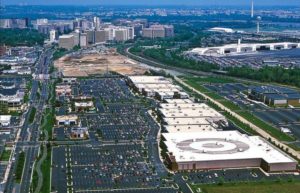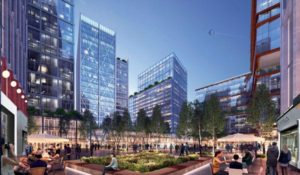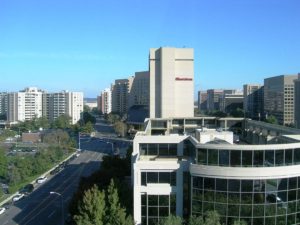This Guest Article for REVITALIZATION was written by Gareth Potts.
In mid-February retail and web services giant Amazon announced that, due to community opposition, it was pulling out of its choice to make Queens, New York City one of two sites for its second headquarters (HQ2).
This came after nearly a year and a half of seeing over 200 North American cities vying to be the sole home of HQ2 through promising substantial financial and other incentives; and spending millions of dollars and state and local officials’ hours putting together bids.
The company is instead now moving forward with a project that, in employment terms, is half the size. The remaining site chosen—Crystal City, a section of Arlington, Virginia (where REVITALIZATION is published)—is in the region, Metro DC, that for many, was always in the lead.
Amazon’s owner, Jeff Bezos, had bought a home there in the previous year, adding to his 2013 purchase of The Washington Post. This all raises the question of just how real the 50,000 jobs figure was in the first place, and of whether this was ever about site selection.
Certainly, this was no conventional corporate location search but was instead a controversial “reverse procurement” where a major corporation asked the public sector and public-private partnerships to compete for its “business” – something traditionally not even thought of as the rightful role of government. The evidence now suggests that the need was instead for evidence gathering, education and consensus-building.
So, what have we learned from all this that might make big inward investment projects more harmonious in future? Here are my four “take-aways”:
(1) Failure to adequately explain incentives makes it harder to secure political buy-in
To read much of the media and political commentary on the HQ2 competition you could be forgiven for thinking that financial incentives offered to lure the company took the form of grant money being taken from an existing State/City budget. Inevitably such a description will make the term “incentives” unpalatable for many – especially in cities with high-need areas.
If you read all the commentary—and how many people outside economic development have time for that—you would see however that incentives often involve promised tax abatements/breaks (i.e. taxes foregone by government) that only kick in when promised jobs, property development and, even, hotel stays, have been delivered.
You would also read that incentives can also include infrastructure that is needed by, but not exclusively for, a company and ‘payment in lieu of taxes’ in which property taxes are diverted to enhance the project area (which could be seen either as diverting taxes to the company or making a project pay for itself).
(2) Discerning potential impacts requires deal transparency
Commentary on potential impacts of the development focused on both positive and negative effects. On the positive side, these included direct and indirect employment growth and property development.
On the negative side, we heard about possible housing displacement caused by highly-paid in-migrating workers and a reinforcement of “uneven development” whereby economically strong cities get stronger whilst their weaker counterparts get weaker.
This “impacts” focus largely obscured the fact that successful site selection requires an engagement with the community to mitigate negative impacts and trumpet the positive ones. This is not to say, necessarily, that Crystal City got this right, merely that it appears to be just such a failure that has already put an end to Amazon’s hopes to grow in Queens.
Whilst cities were free to disclose their bids, since Amazon only forbade disclosure of company-specific information, many elected not to do so. The competition even saw some elected city officials not knowing the strategy pursued, on their city’s behalf, by their State leaders. Toronto was impressive for disclosing its bid early on. Bidders defended this secrecy as a necessary evil important to success in this and future competition.
Despite the structure of the Amazon competition being focused on ‘best bid’ rather than highest community impact, the company seemed to believe that a host community was somehow going to be welcoming after what amounted to a backroom deal. Queens has shown that communities require transparency and engagement to secure their buy-in.
This all leads into the slightly wider question about whether secrecy can ever be a legitimate function of government or a partnership accountable to residents and funded by local tax dollars.
Real competitiveness can still include “place marketing” to attract mobile firms and workers, albeit where this is transparent to public scrutiny and, as already often occurs, performance-related.
(3) Modern tech companies care most about places that can attract and retain talent
As expected, Amazon didn’t simply plump for the cities offering the most incentives.
It had, notably in its Request for Proposals (RFP), highlighted an interest in a range of wider place factors – several of them with progressive intentions.
Thus, the RFP talked about wanting a “diverse population” – the result of tech worker liberal values (for example, Bezos had backed a same-sex marriage ballot in Washington State) and the self-interest of wanting to draw from a deep pool of talent. Toronto’s pitch highlighted Canada’s progressive policies, including embracing same-sex marriage.
The company wanted mass transit – important in getting thousands of workers to and from their workplace (their main concern) but also valuable in addressing a city’s environmental impact and access to transport for those without cars. So, for example, in its feedback to Detroit it stressed that the absence of regional mass transit had been a factor in the area’s not having been short-listed (feedback civic leaders have taken to heart).
Other issues cited in the RFP included low crime, housing affordability and recreational opportunities. Underpinning all of this is a concern for places that are attractive to talent – which all commentators agree was far and away the most important selection criteria.
It seemed that Amazon probably realized this whereas some cities thought more tax breaks might be the answer. Can financial incentives ever be a match for long term investment in assets that make mobile talent want to come and stick around? It is important to embed incoming firms through ties with local businesses, colleges and universities but, without embedding workers, this will prove short-lived.
(4) A major HQ2 controversy has been around what might be called the “competition dividend”

The redevelopment of underused property between Crystal City and Potomac Yards in Alexandria, Virginia. Photo courtesy of McCaffrey Interests, Inc.
Incentives only matter when a place provides the necessary criteria for a business to be successful; in other words, the sort of assets described in the previous section, most of which could be found in the places represented in the top twenty finalists.
Many commentators observed that these cities bidding against each other with financial incentives to attract HQ2 (and other mobile companies) is wasteful of public resources – if they didn’t engage in a bidding competition the city chosen would save a fortune in public funds. To help focus attention on this issue we could call the extra incentives offered the ‘competition dividend’.
Even without such incentives, the two places selected were already international hubs for tech talent and arguably the best locations for some of the key lines of business intended to operate out of those sites – media work (New York) and government relations (metro DC). They maybe didn’t even need to have offered any competition dividend to win.
Real city competitiveness can still include a low-business-tax climate and business support and areas offering this might well prove popular to those companies looking to move location. However, this climate should be for all business in a city. Creating a level playing field in terms of taxes and incentives not only avoids poaching but also makes inward investment more politically palatable for the many companies and workers that aren’t looking to simply ‘up sticks’ and move.
Commentators discussed various solutions as to how to stop wasteful bidding wars: a national law or executive order forbidding or heavily taxing inward investment incentives; means-testing companies seeking benefits; withholding federal funds from governors and mayors; awarding federal funds to places that don’t play the incentives game; increased federal support for disadvantaged metro economies; and a non-aggression pact between North American cities.
Inevitably the devil would lie in the detail of operationalizing these ideas, but the HQ2 process has surely raised the possibility of there being a Commission, research program or conference to examine them?
The real legacy of the HQ2 search may be a better approach to big corporate relocation. For all its controversies, the process has shone a light on the many ways in which major companies looking to expand employment in new cities need to work with their prospective host communities – a partnership not a procurement.
About the Author
Dr. Gareth Potts is an urbanism research and policy consultant. Currently a resident of Washington, DC, he is an urbanist with expertise in community-driven economic development. He has international experience having worked in the UK, US, and having led a report on French urban policy for the UK Government. His U.S. experience includes research on the future of economic development, resiliency in areas hit by extreme weather, encouraging cross-continental best practice between France and the U.S. and advising a community adjacent to UnderArmor’s proposed Port Covington development. Gareth is a British citizen who came to the U.S. in 2012 – initially on a German Marshall Fund Fellowship, which he developed into an international platform to share knowledge around sustaining community and civic assets: http://www.thenewbarnraising.com.
Before this he worked: in the Prime Minister’s Strategy Unit as a policy advisor; and as the director of research and policy at the former British Urban Regeneration Association. Gareth has also: advised local government on inclusive economic development in London; been senior researcher at think-and-do tanks the New Economics Foundation and Young Foundation and a program manager at Marsh Farm Community Development Trust in Luton. Gareth holds a PhD in economic geography, a Master’s in Civic Design and, after his PhD, was a post-doctoral Fellow on a major research project on economic competitiveness and social cohesion in London led by the late Professor Sir Peter Hall. He writes here in a personal capacity – and his views do not, necessarily, represent those of any current or recent employer.






